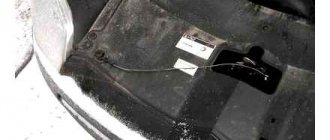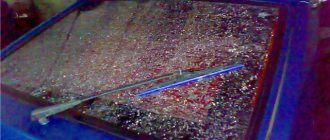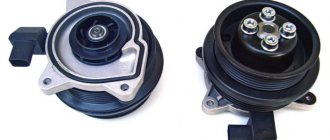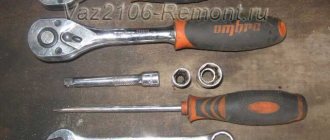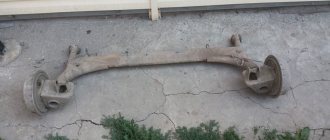As usual, in the fall, car enthusiasts rejoice at the last warmth, since winter will soon come, which will bring frosts, and, consequently, problems for cars. During winter, very low temperatures at night are common. The car travels a large number of kilometers in winter, after which it is parked. While the owner was doing his business, the engine had time to cool down, and when the driver arrived, the car needed to be warmed up again. This operation will have to be carried out constantly until the car owner resorts to purchasing and installing insulation under the hood. Thanks to this improvement, the motor will cool down longer, which means it can be used even after several hours of inactivity.
Why did they even come up with insulating the engine compartment?
Motorists note that in winter it is much more difficult to start the engine. Starting a cold engine is a blow to its life. And everything happens like this because in extreme cold the physical properties of oils and fuel in the car’s systems change.
Frost causes the lubricant to thicken and stop penetrating into hard-to-reach corners of the engine. Lack of lubrication negatively affects the stable operation of the engine. The piston group and cylinders will first feel that there is not enough lubrication. The so-called oil starvation causes the pistons to move “dry”. You can’t save on insulation so that you don’t have to bite yourself later.
In addition, you can insulate the hood of your Lada for only 1000 rubles. It will be much cheaper to buy and install insulation on the hood than to carry out a major overhaul of the internal combustion engine. It should also be noted that when fuel freezes, just like lubricant, it changes its physical properties. Frozen fuel practically does not evaporate, which worsens the rich mixture. In winter, the battery suffers no less. The charge is already more difficult to release. Even poured special oil, which, as a rule, should help with starting, will do nothing in severe frosts.
With your own hands
How you can insulate the engine compartment yourself using a car blanket:
- Spread it on the engine with the hood open. So that the blanket completely covers the entire compartment. The size of the blanket will be different for each model;
- If you purchased insulation and the compartment is not standard, you can tuck the material around the edges;
- The procedure for insulating a car with your own hands is carried out in the last month of autumn, closer to frost;
- You need to remove it in the spring, when it gets warmer and the frosts subside;
- There is no need to remove the insulation at night; let it lie there all winter;
- Washing car blankets is not allowed, you can only dry clean;
- Removing engine insulation with your own hands is as easy as laying it, then roll it up and put it in a bag until next winter;
- A good branded blanket lasts for two seasons, when you drive a car every day, it pays for itself in the first year;
- Because accelerated warming up saves gasoline and time, and, accordingly, your money;
Insulation with special materials:
- There are different insulation materials, some of them are harder, and then the engine compartment insulation is attached to the hood, rather than spread over the engine;
- Installation is then preferable at a temperature of about +20, (for example in a heated garage) for better elasticity of the material;
- The hood must be cleaned of dust and dirt and even washed if necessary and dried after washing.
- Treat rusty areas to remove rust and prime them;
Useful material about car blankets
Rigid insulation is secured either with a self-adhesive base or with plastic clips at the spaces between the stiffeners. There are also clips for attaching to the stiffeners themselves;
However, such insulation also needs to be removed in the summer so as not to overheat the engine.
That's all, friends, don't forget to subscribe to updates on my site, tell your friends, or better yet, send them a link, see you later.
What can you say about the standard insulation?
It is worth noting that the factory insulation is not designed for Russian winters. With the arrival of really severe cold weather, this material becomes practically useless. It has proven itself well in countries with warm climates, where winters with a maximum comfortable temperature are -10 degrees. Therefore, you should choose additional insulation before winter. Some factories specially produce cars that are already prepared in advance for cold countries. Such cars are already equipped with serious insulation that can withstand severe frosts. Other versions do not have this innovation. In order to somehow help themselves, car owners independently equip their “iron horses”.
The lineup
Models of blankets have their own number, which corresponds to a particular brand of car, for example:
- For AUDI 80, Autoteplo 11 costs 1,750 rubles. The length of the product is 90 cm and the width is 155 cm. If you are the owner of an Audi 100, then you need to buy insulation number 15, which will cost a little more (1900 rubles).
- For BMW3, choose “Autoheat 3” for 1,700 rubles, and for X6, the same model as for Audi 80 is suitable.
- Owners of KIA Soul and Spectra will benefit from car blanket No. 2, and for Picanto – No. 20. Models also cost around 1,700 rubles.
- For the domestic VAZ 2101, choose No. 10, and if you are the owner of a Lada Kalina, then “Avtoteplo 6” is suitable for this brand.
The list can be continued indefinitely, since the manufacturer took care of the owners of all car brands known to mankind. Among the model range you can find products even for such a rare car as Pontiac, so you don’t have to adjust the insulation to size.
What to choose for hood insulation?
Car owners insulate the engine compartment with any available items. The most commonly used are professional blankets and felt. Felt itself is a good insulator, but the problem is that a piece of sufficient size is difficult to find, and it is difficult to sew. This kind of insulation helps, but is not enough. You can purchase professional capes designed for this purpose.
Separate kits are produced for each brand. The main advantage of choosing branded insulation is the ease of fastening and dismantling. The production of such products is established only in small batches in private firms. Therefore, purchasing such professional insulation is not easy. Manufacturers present two types of insulation on the market: for the hood and for the entire car. Few people use the second option, since it is expensive and difficult. Most drivers simply insulate the engine compartment with something made with their own hands.
How and with what to cover a car’s gasoline engine in winter without the help of a car service
Low temperatures also negatively affect the performance characteristics of a gasoline engine, as well as a diesel unit.
The first step is to pay attention to the thermal insulation of the radiator, for which you can use ordinary cardboard if you don’t want to bother too much. Aesthetes, of course, will prefer to either order a special cover from a sewing workshop using proven patterns, or buy a finished industrial product
They are usually made of artificial leather and insulation. The design of most samples includes valves that can be opened when the temperature rises, which will prevent the motor from overheating.
If the factory version of the car model does not provide thermal insulation for the hood, then this will have to be done separately. You can independently organize such insulation using felt, foiled polypropylene or mineral wool. Having decided the question of how to cover a car’s gasoline engine in winter, it is additionally recommended to protect its lower part. The technology for thermal insulation of the lower area of the internal combustion engine is as follows:
- Remove the crankcase protection and clean its surface from dirt and oil stains.
- Cut the thermal insulation to the size of the protection and secure it with glue or double-sided tape. The dimensions of the insulation should be 10-20 mm larger than the protective plate in order to cover the attachment points.
- Degrease the crankcase, cut out the foam insulation according to the pattern, and glue it to the crankcase.
- Cover the side surfaces of the engine compartment with thermofoil.
On some cars with high ground clearance, the insulation can be secured to the protection using gazelle clips. To do this, 4 holes of the appropriate diameter are drilled along the bumper, after which the insulation is fixed through them. Next, it is attached with clips through the drainage holes to the suspension arms and side members.
Who produces insulation?
There are few manufacturers of hood insulation. “Standard-Plast”, “Standard” and “Hermes” have proven themselves well in the market. Customer reviews are only positive. "Standard" produces insulation materials "Isoflex" and "Tiviplen". "TiviplenP" is made of polyethylene foam and equipped with a self-adhesive surface. In addition, this insulation contains a PVC layer, but it does not contain foil. Her absence does not prevent him from fulfilling his task. The thickness of the products varies from four to fifteen millimeters. Isoflex is not well suited for engine insulation, as it has more sound-proofing properties than heat-insulating ones. The products of these companies are universal and can be used not only for protection from the cold, but also to get rid of noise.
What is a car blanket?
You can buy hood insulation at an auto parts store without any problems. Wide selection of models. But, if a person has the necessary materials and is not afraid to take on unfamiliar work, then he can make such an accessory himself. This blanket is based on special cotton wool. Sometimes there is even glass wool. Such material can be taken from a fireproof shield. In industry, glass wool is used to insulate gas and oil pipelines.
The positive properties are that this material conducts heat poorly and does not burn. Fiberglass fabric withstands high temperatures and is also neutral with respect to various chemical liquids. Thanks to this material, you will need to spend not 15, but 3 minutes to warm up the car. In addition, if you leave the car after a trip, you can start it without problems, and the temperature sensor will be at operating level. The cost of such blankets is very high, but the result is a very big plus in efficiency.
Car products that the market offers
Today, there are several types of engine blankets that differ in material, characteristics and dimensions.
When choosing a product, you should focus on the following parameters:
- Car make (dimensions depend on this);
- Width;
- length;
- Weight;
- The presence of a cutout for a lock;
- Operating temperature requirements;
- Price.
Let's look at the main options:
Car blanket brand A-1.
This insulation is enough to keep the engine warm. The product is manufactured using the best materials, using modern technology and taking into account current standards.
Car blankets are resistant to chemical influences, the passage of electric current and excessive heat.
The operating temperature of A-1 brand products is in the range of -60 ... +650 degrees Celsius. At the same time, the covering material can withstand temperatures up to 650 degrees Celsius, and the blanket filler can withstand temperatures up to 1200 C.
This type of product is suitable for thermal insulation of gasoline and diesel engines.
Thanks to its dielectric properties, you don’t have to worry about accidentally shorting the terminals to the battery.
An important point is the size and the presence of special cutouts. That is why the choice of blanket should be made taking into account the model and make of the car.
Car blanket brand A-2.
Like the previous model, this is a universal product designed for insulation of various types of engines (running on gasoline or diesel).
The use of such a blanket in winter ensures quick warm-up of the engine, increases the service life of the battery and engine, and reduces fuel consumption.
Thanks to its resistance to negative influences (alkalies, acids, high temperatures), the car blanket can last for more than one year.
The main difference is the ability to work in a wide range of temperatures - from 60 degrees below zero to 1200 degrees Celsius.
A blanket of this brand is a dielectric, so touching the battery terminals does not lead to a short circuit.
Scope of application - insulation of engines of any equipment where internal combustion engines are installed.
The insulation contains the following materials:
- Silica tissue;
- Fiberglass threads;
- Mullite-silica wool.
Thanks to this composition, effective thermal insulation of the hood is ensured while retaining heat in the engine compartment.
The main advantages of a car blanket:
- Ability to withstand temperatures up to 1200 degrees Celsius;
- Long-term retention of engine heat;
- Non-flammable;
- Protection of the hood from ice formation.
There are many other modifications of car engine blankets. As a rule, the material from which they are made is the same, the only difference is in size and shape.
How to properly insulate a hood?
To protect the engine, you can use a car blanket. But what to do if you need to insulate the hood? Experts recommend installing polypropylene foam, which is stitched with foil. This material sits on the shelves of construction supermarkets. It is perfect because it does not allow heat to pass through and perfectly protects the engine from incoming cold.
This material is not afraid of high temperatures, so it is perfect for insulating the hood of a car. The thickness varies. It is best to choose a product with a thickness of no more than 2 cm. You can make insulation yourself from purchased material. To do this, it is necessary to give a piece of material a shape that maximally follows the silhouette of the car hood. The resulting insulation must be attached using special clips. The remaining material is used to insulate the stiffeners on the hood.
Closing the car grille
The final touch in the matter of thermal insulation is the closing of the radiator grille, through which cold air flows. If nothing is done, insulating the hood will not give much results.
The car owner has several options at his disposal:
- Using ordinary cardboard (this option is often found on Gazelles). For obvious reasons, it is not suitable for passenger cars.
- The use of special radiator grilles in which the blinds are closed (available for some models of foreign cars).
- Preparation and fastening of a suitable piece using foil insulation.
Next, it wouldn’t hurt to soundproof the car’s fender liner.
It is important to know
Before gluing the insulation, you need to clean and degrease the surface. This will ensure that the material does not come off while moving. Now the engine will not be afraid of even the most severe frosts. The car can be operated without fear that the engine will simply need to be warmed up. It is important to note that thanks to this improvement, ice will no longer accumulate on the hood. Plus, all the material is available anywhere. Insulation with foil applied to it is perfect for solving this problem. By the way, this material is very cheap, and its properties are in no way inferior to professional blankets.
Technology
Naturally, the hoods of all cars are completely different, and for this reason there are no unique patterns. For each individual car, you need to make your own so that it fits perfectly on the back of the hood. You can use the simplest roll of wallpaper as a draft.
But here the question arises regarding how to attach this very wallpaper to the hood. For this purpose, specialized clips are sold in car dealerships. They allow you to secure the necessary material and design its cutout directly along the edges of the structure.
It is the ribs that are quite the problematic area in this situation, and it is for this reason that they are given additional rigidity. This can be done thanks to a substance such as Izolon. It is worth noting here that the substance needed is about 10–20 mm. thick. No more.
To do this you will have to use 2 layers of sealant
. All this is connected to each other with a special glue, layer by layer the materials are glued to each other, along the way, all this is fastened with special bolts in places where there are pre-prepared holes. This method is the simplest and most effective. You can create such insulation at home, spending a minimum of time and effort on it.
But, as mentioned earlier, this type of insulation is not the only one of its kind. No less common is insulation, in the form of a special blanket to cover the entire engine compartment. It doesn't look very nice, since such things are most often produced in white.
This blanket gets dirty very quickly, but despite this it does its job, and does it properly, which is good news.
Tests to determine the best insulation
Experts conducted many comparisons in which they determined the best material. The “test subjects” were penofol with applied foil, a special blanket and felt. Also, native Zhiguli insulation materials were added to the competition, but they passed out of the competition, showing not the best results. The measurements were carried out three times. In the first experiment, they measured the period of time during which the engine could warm up to operating temperature. In the second - the time during which the unit cools down. The third test was aimed at determining the degree of ignition. All experiments were carried out at a temperature of -20 degrees.
In the first test, the car was warmed up for 10 minutes. In one case, insulation was installed, and in the second, not. According to the results, it turned out that the motor with the blanket cooled down completely in 6 hours. The standard installation insulation lasted 4 hours. The foil material did not allow the engine to cool for 3.5 hours. This is a good result, since the motor without insulation cooled down in 3 hours. The felt achieved an average result; it cooled for 5 hours. What about the third competition - the best ignition rate for a car blanket. Insulation with applied foil is very cheap, but it also burns very well. If a short circuit occurs, this material will ignite within seconds. In addition, if the foil insulation is installed incorrectly and sagging appears, then the battery terminals can reach the protection and close the circuit.
Sound insulation of cars using building materials. Is this alternative worth using?
- Do not use polyethylene foam for sound absorption. Despite the assurances of sellers, its noise insulation coefficient is highly exaggerated and in reality tends to zero. Rather, it can be attributed to waterproofing;
- You shouldn’t rely on foam rubber either. Its main functions are insulating; besides, it is quite difficult to fix it;
- Do not believe advertisements praising the sound-absorbing qualities of splen. It is expensive, but in fact it is also insulation;
- The use of foam pads under laminate flooring can only be of limited use. Firstly, they are not resistant enough to mechanical stress. Secondly, their moisture resistance is low. If you lay them on the floor in the cabin in the fall/winter/spring, when there is a lot of rainfall, the gaskets will fail within a month. Although insulating the wheel arches in the trunk with them is a completely acceptable idea;
- Felt is an excellent sound insulator. However, it has the unpleasant feature of absorbing water and being reluctant to give it away. If you decide to lay it on the floor, make the mats removable and replaceable - some dry, others work. Or seal it in construction polyethylene. But for insulating the body - doors, roof, etc. - it is suitable without meeting any conditions.
- An ordinary construction waterproofing agent is purchased - a bitumen sheet layered with fiberglass. It will act as a vibration isolator. Standard roll of 10 sq. m is enough to process a car of any size;
- Patterns are made according to the isolated areas, from which blanks are cut;
- The standard casing is removed; if there are rattling objects underneath (there are especially many of them in doors), they are wrapped in rags or electrical tape;
- The surface is degreased with white spirit, and the pattern is glued to it - pressing and smoothing. Glue 88 is ideal for fixation; it bonds the insulator to the metal to death;
- Then, at a minimum, the joints between the plates are glued with Guerlain tape - a product made of butyl rubber with a foil surface;
- It’s better not to be lazy, but to cover the entire insulated area with it: guerlain will make the waterproofing material heavier and increase the degree of vibration absorption. In addition, it does not dry out under the influence of external factors, so it will protect the bitumen layer from destruction. There is no need to worry about the health of the salon’s population: guerlain is harmless and approved for use in residential premises;
- The third layer will be the sound insulator itself. Instead of pure felt, you can buy a carpet made from it with a bitumen coating - this will protect the material from moisture. Using the same patterns, blanks are made and attached on top of the guerlain;
- The hood and trunk lids can be insulated with floor linoleum. You need to take a thick variety that has a waterproof base. Linoleum is glued using automotive bitumen, and foamed polyethylene with a foil layer is glued on top of it. The thickness of the top coating is not less than 5 mm. This insulation option is preferable to others because it does not make the lids too heavy.
AutoFlit.ru
We draw a conclusion
With such seemingly inexpensive and easy-to-maintain things, you can thoroughly prepare for the coming winter, which comes unnoticed. No need to wait for the first frost. You need to immediately buy the necessary materials and make patterns. Or there is an option to use standard insulation.
Thanks to this improvement, the power unit will operate more efficiently. In addition, the likelihood of breakdown, in this case, will be much reduced. Good insulation of the engine compartment will improve engine performance and also reduce fuel consumption to autumn levels. Very frequent and sharp temperature changes will not occur, which will greatly delay the process of “overhauling” the power unit. The article describes well all possible insulation for the hood, so after reading the article, everyone should learn a worthy lesson.
Salon
After completion of work with insulation of the engine compartment, the next stage is thermal insulation of the car interior.
The goal of the car enthusiast here is clear - to retain heat in the car interior and speed up the heating of the interior by the stove in winter.
This work is relevant not only for cars of the domestic automobile industry (for obvious reasons), but also for foreign cars.
Thanks to high-quality insulation and effective athermal tinting, it is possible to maintain heat in the cabin longer, even without turning on the stove.
At the same time, modern materials provide excellent sound insulation, which provides additional comfort during the trip.


